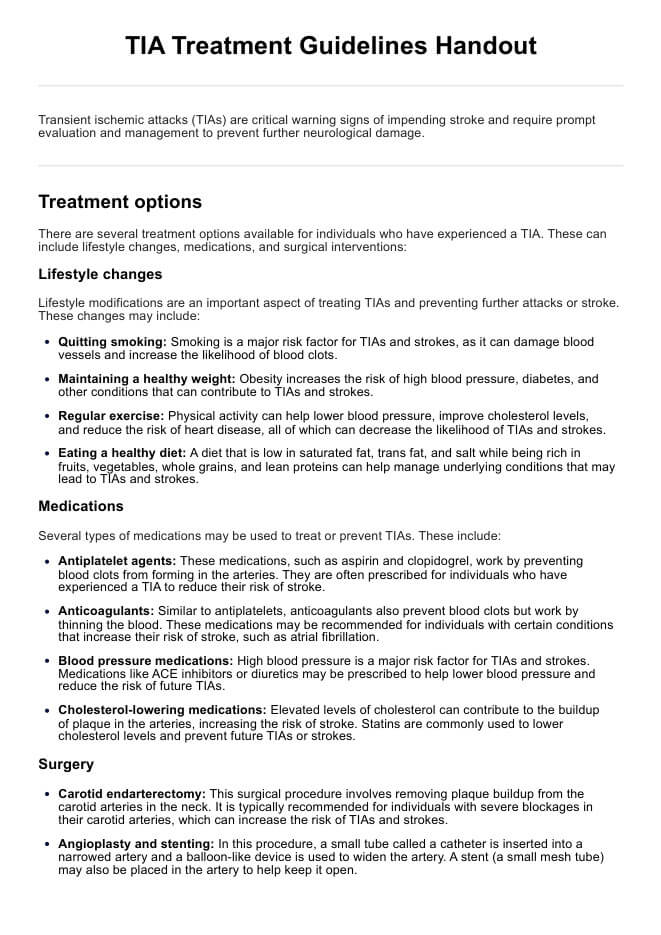TIA Treatment Guidelines Handout
Download Carepatron's free PDF handout and example for TIA treatment guidelines to help provide information and guidance on treating transient ischemic attacks (TIAs).


What is a transient ischemic attack (TIA)?
A transient ischemic attack (TIA), often referred to as a mini-stroke, is a temporary period of neurological dysfunction caused by a brief interruption in the blood supply to part of the brain. Unlike an ischemic stroke, which results in permanent brain damage, the symptoms of a TIA typically resolve within minutes to hours without causing lasting harm. However, a TIA serves as a critical warning sign of a very early stroke risk, indicating that patients with TIA are at a higher risk of experiencing a recurrent stroke.
TIAs share many risk factors with acute ischemic stroke, including high blood pressure, atrial fibrillation, and peripheral vascular disease. The occurrence of a TIA is a medical emergency, as timely intervention can significantly reduce the likelihood of a future stroke or transient ischemic attack. Effective secondary stroke prevention strategies, such as managing blood pressure, controlling cholesterol levels, and addressing lifestyle factors, are essential in mitigating this risk.
Symptoms of transient ischemic attacks
Recognizing the symptoms of a transient ischemic attack (TIA) is crucial for timely intervention and reducing the risk of a future stroke. Here are the key symptoms to watch for:
- Sudden weakness or numbness on one side of the body, often affecting the face, arm, or leg
- Difficulty speaking or understanding speech, often described as slurred or garbled speech
- Vision problems in one or both eyes, such as blurred or double vision, or sudden loss of vision
- Dizziness or loss of balance and coordination, making it hard to walk or stand
- Severe headache with no known cause, which may be sudden and intense
- Confusion or difficulty comprehending simple instructions or tasks
TIA Treatment Guidelines Handout Template
TIA Treatment Guidelines Handout Sample
How are transient ischemic attacks treated?
Treating a transient ischemic attack (TIA) promptly is vital to prevent a future stroke and manage the associated increased risk. The primary goal is to reduce the likelihood of a recurrent stroke through various strategies. Here are the key treatment approaches for managing TIAs:
Lifestyle changes and risk factor management
For patients with TIA, adopting a healthy lifestyle is essential. This includes quitting smoking, maintaining a balanced diet, exercising regularly, and managing conditions like hypertension and diabetes. These changes help reduce the overall stroke risk and improve general health.
Medications
Aggressive medical management with medications is often necessary. Antiplatelet drugs, such as aspirin, or anticoagulants, like warfarin, are commonly prescribed to prevent blood clots that could lead to a minor ischemic stroke or ischemic stroke. Statins may also be used to lower cholesterol levels and further reduce stroke risk.
Carotid endarterectomy
For patients with significant carotid artery narrowing, a carotid endarterectomy might be recommended. This surgical procedure involves removing plaque from the carotid arteries to improve blood flow to the brain, reducing the risk of a stroke or transient ischemic attack.
Angioplasty and stenting
An alternative to carotid endarterectomy is angioplasty with stenting. This minimally invasive procedure involves widening the narrowed artery and placing a stent to keep it open, ensuring adequate blood flow and reducing the risk of a recurrent stroke.
Monitoring and follow-up
Continuous monitoring and regular follow-up appointments are crucial for patients with TIA. This allows healthcare providers to assess the effectiveness of the treatment plan, make necessary adjustments, and promptly address any new symptoms, thereby preventing a minor stroke or recurrent stroke.
How to use our TIA Treatment Guidelines Handout template
Carepatron's TIA Treatment Guidelines Handout template is designed to assist medical professionals in effectively managing patients who have experienced a transient ischemic attack. This user-friendly tool helps streamline the assessment, treatment process, ensuring comprehensive care. Follow these steps to utilize the template:
Step 1: Download the template
Get a copy of the TIA Treatment Guidelines Handout template from Carepatron's website. It's also available in our app.
Step 2: Familiarize yourself with the sections
Read through the template and familiarize yourself with the different sections. Each section is carefully curated to provide essential information for treating TIA.
Step 3: Use as a reference
The template can be used as a quick reference guide during patient consultations. It provides concise information that is easy to understand and follow.
Step 4: Share with patients
The TIA Treatment Guidelines Handout template can also be shared with transient ischemic attack patients or their caregivers as an educational resource about transient. This helps them understand the condition better and empowers them to take an active role in their recovery journey.
How healthcare professionals will benefit from this handout
Healthcare professionals will greatly benefit from Carepatron's TIA Treatment Guidelines Handout by having a structured and efficient tool to manage high-risk patients effectively.
This handout facilitates thorough clinical diagnosis by documenting medical history, neurological symptoms, and utilizing diagnostic tools like magnetic resonance imaging. It aids in identifying patients with atrial fibrillation and carotid artery issues, allowing for timely and appropriate treatment.
Moreover, the handout supports risk modification strategies, including antiplatelet therapy and aggressive medical therapy, essential for reducing the risk of stroke. Cardiovascular nursing professionals will find it invaluable for monitoring and follow-up, ensuring that possible transient ischemic attack patients receive comprehensive care.
Commonly asked questions
The usual treatment for a TIA involves managing underlying risk factors such as hypertension, diabetes, and high cholesterol through lifestyle changes and medications to prevent a future stroke.
Antiplatelet therapy, typically with aspirin, is considered the first line of medication for TIA to reduce the risk of blood clot formation that can lead to a stroke.
Immediately after a transient ischaemic attack (TIA), seek medical attention even if symptoms have resolved. It's crucial to undergo diagnostic tests to determine the cause and receive appropriate treatment to prevent a recurrent stroke risk.







































































































